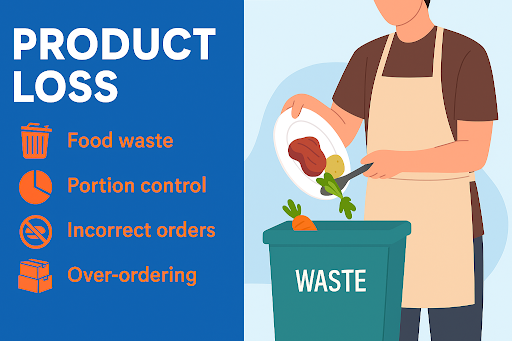Running a restaurant is a tough business. Margins are razor-thin, competition is fierce, and even small inefficiencies can eat away at your profits. One of the most overlooked threats to a restaurant’s bottom line? Total loss.
Total loss refers to the combined impact of controllable factors like waste, theft, labor inefficiencies, and operational breakdowns that silently erode your profit margins. If you’re not tracking and managing these losses proactively, you’re leaving serious money on the table.
Let’s break down what total loss really means, how to measure it, and what you can do to stop the financial bleeding.
What Is Total Loss in a Restaurant?
Total loss includes three major categories:
1. Product Loss
These are losses tied directly to your food and beverage operations:
- Food waste (expired, spoiled, burned, over-prepped, or dropped items)
- Portion control issues
- Incorrect orders or comped meals
- Over-ordering or poor storage practices
2. Financial Loss
Often preventable, these involve theft or abuse:
- Cash theft, fake refunds, or comps misuse
- Employee or customer discount abuse
- Inventory shrinkage (missing alcohol, high-cost ingredients)
3. Operational Loss
These occur when your processes fail:
- Poor scheduling (overstaffing or understaffing)
- Inefficient prep routines
- Equipment failures that cause spoilage
- Inconsistent execution that slows service or leads to walkouts
How to Measure Total Loss
You can’t fix what you don’t measure. Start here:
1. Track Key Loss Indicators
- Food cost variance (actual vs. theoretical cost)
- Waste logs (document all discarded food and reasons)
- Inventory variance (beginning + purchases – ending vs. sales)
- POS exception reports (track voids, discounts, refunds)
2. Calculate Loss as a % of Sales
Total Loss % = (Value of all losses / Total Sales) × 100
Break down by category for more clarity:
- Waste loss %
- Theft/fraud loss %
- Labor inefficiency %
- Spoilage/breakage %
What Can a Restaurant Loss Prevention Consultant Do?
If you’re struggling to get a handle on your losses, a consultant can provide the systems, tools, and expertise to identify the problem and stop it.
1. Food Cost & Waste Audits
- Analyze usage vs. sales
- Implement prep logs, yield calculators, and smart portioning tools
2. Inventory Control Systems
- Establish daily counts for high-theft items
- Audit your receiving process to prevent vendor fraud
3. POS Exception Monitoring
- Track and flag excessive voids, refunds, or comps
- Identify patterns by employee or shift
4. Training & SOP Implementation
- Train staff on portion control, waste tracking, and fraud prevention
- Implement standard cash handling and inventory procedures
5. Surveillance & Technology
- Use video analytics to monitor prep areas and register activity
- Pair footage with transaction logs for detailed audits
6. Labor Optimization
- Review sales-to-labor ratios
- Eliminate overstaffing or underutilization during slow periods
Real Example: What Total Loss Looks Like
Let’s say you operate a casual dining restaurant with $1.2M in annual sales. Your ideal food cost is 28% ($336,000), but your actual food cost is 32% ($384,000). That’s a $48,000 loss just from overuse, spoilage, or theft.
Now add:
- $15,000 in POS-related fraud (voids, comps, refunds)
- $10,000 in labor inefficiency
That’s $73,000 in total avoidable loss money that could’ve been profit.
Bottom Line
Total loss is a silent profit killer. It’s not always dramatic, but it’s always dangerous. It’s not just about theft; it’s about all the small, preventable breakdowns in food handling, staff scheduling, and operations that chip away at your profitability.
A strong total loss prevention strategy isn’t optional; it’s essential.
Want to reduce your restaurant’s total loss?
A loss prevention audit might be the smartest investment you make this year.
Contact Us
